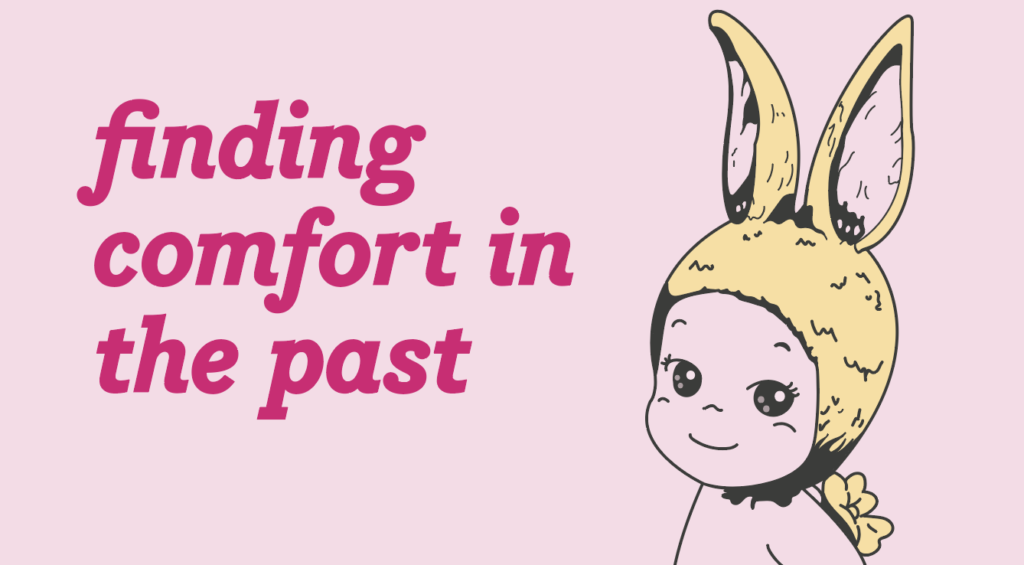Featured illustration: Snehal Dhanwate
From fashion model and tiny toy collector Iris Law to singer-songwriter Beabadoobee leading the 90s cuteness revival, capitalism and cuteness go hand in hand. We dive into the trends paving the way for us to dip into our childhoods.
From a cracked hard teddy you’ve cuddled since childhood – when it was soft – to an annoying Tamagotchi that just won’t die, or even a schoolgirl prairie dress reminiscent of simpler days, nostalgia can come in many forms. In a world so serious, nostalgia can make us feel safe and act as a comfort blanket when the world gets too harsh. When the Sunday Scaries hit and your seminars are making you question if you’ve chosen the right course, you might just find a miniature plastic toy to be your saviour.
Sonny Angels are just one example of nostalgic comforts created for young women to help deal with the stresses of adulthood. This collectible toy was created by Toru Soeya, the CEO of Japanese company Dreams, and is inspired by the American cartoon ‘Kewpie’. Described on their website as a ‘little angel boy’, the small naked baby in a variety of headgear claims to be ready to provide ‘healing moments’ in the everyday lives of fans.
“It improves my day when I buy a Sonny Angel because of the dopamine rush of opening the surprise box,” says Amelia Godel, head of MMU Fashion Society. “I love them because of the collecting aspect and how they are physical objects in an age where everything is digital. Being able to look at them in my room, in my studio or wearing them as part of my outfits feels better than looking at things on a screen.”
One of the features collectors enjoy about Sonny Angel mini figures is the ‘blind box’ packaging; meaning buyers do not know which figure they will receive until they buy one and open the box. This edged excitement is capitalised on by character-led companies, with fans buying box after box until they get the figure they really want, often documenting the process on social media.
“The surprise element [of blind boxes] is reminiscent of toys that were available when we were much younger,” says Amelia. “It keeps you coming back to purchase another to chase the thrill of getting the one you really want, or just a different one to the ones you already have.”
Japanese brand Sanrio dominates the market with its blind box sales, offering consumers an addictive dopamine rush. Best known for its Hello Kitty brand, the adorable character celebrates its 50th anniversary this year with a new exhibition at Somerset House in London. Featuring artists including Japanese painter AYA TAKANO and interdisciplinary artist Sain Fan in collaboration with Sanrio, the event will explore the irresistible force of cuteness in contemporary culture.
The enduring appeal of Hello Kitty is complemented by a rising trend in the popularity of other nostalgic collectibles, including Sonny Angels and Sylvanian Families. Amelia says: “I think people really enjoy revisiting [these toys], particularly ones you can collect and display rather than ‘play’ with or trade, as they start to move into their own spaces, whether that be in uni halls, student houses or first homes.”
Despite providing comfort and enjoyment, these collectibles also have the power to put a dent in your bank account. The Sonny Angels cherub toys, first made popular in Japan and collected around the world, do not come cheap. Each figure sells for about £10 each, and is part of a series of themed headgear – sailors, animals, fruit, vegetables. In total there are 650 dolls to collect, with the rare ‘Robby Angel’ appearing on resale sites for an average of £70.
On the market since 2004, the cute Sonny Angels are now regularly sold out. Their resurgence in popularity on social media has contributed to this demand, with the hashtag ‘Sonny Angel’ now reaching more than 800 million posts. This trend is closely followed by another nostalgic toy – the Tamagotchi – which has more than 742.6 million mentions on TikTok.
Iris Law is a fashion model and self-certified ‘cool-weird girl’ who regularly shares her own collection of ‘tiny things’ and nostalgic treasures on her platforms. From Sylvanian Families to her own personal collection of Sonny Angels, Law offers a safe space for those who might have been teased in high school yet went on to embrace their quirks and unconventional interests.
The micro trend of ‘cool-weird girls’ has made its way online, with artists like Beabadoobee and influencer/designer Limnick embracing the aesthetic. Capitalising on a sense of individualism and all things niche, this trend makes individuality fashionable, favouring maximalism and eclectic, colourful outfit choices.
Amelia admits this “gimmicky” trend has influenced not only her own personal style but the way she thinks about spending too. “I’m not necessarily buying more, as I’m already quite careful about my consumption as sustainability is important to me,” she says. “It’s more about finding ways to add things I already own to my outfits or bags, whether that’s upcycling or reusing existing things or being more considerate about what I buy.”
The environmental impact of collecting, overconsumption and following online trends has been called out repeatedly, but it’s clear it can offer an undeniable pleasure to people looking to find comfort in something fun and familiar. This presents a dilemma for fans though, who are also increasingly concerned about the effects of fast fashion and sustainability. “Sometimes the dopamine hit is diminished because I’m also very aware of how the plastic in these toys is not a very sustainable choice,” says Amelia.
Growing up in a world of climate change, pollution and plastic waste, Gen Z is acutely aware of the challenges facing the environment. This is evidenced by recent research data from Mintel, which says around 70% of 16 to 19-year-olds agree that sustainability is an influential factor when purchasing fashion items. This figure is significantly higher than for older generations.
With a generation apparently so in tune with sustainability, why are these plastic toys so popular? As well as favouring tangible physical objects over screens as a way of rejecting constant scrolling for mental stimulation, the answer may lie in the psychological impact of the pandemic. The mental health charity Mind found that 88% of young people admitted the pandemic had a negative effect on their mental health. This period saw many young adults return to childhood bedrooms filled with nostalgia, dusty trinkets and the smell of unwashed teddies – and this could be where the interest was rekindled for some.
Lucy Jane, the owner of the Afflecks clothing swap shop Beg, Steal and Borrow, says there is no surprise we return to familiar comforts and trends years later when times get tough.
She says: “I think this has been fuelled by people who have really latched onto a nostalgia-based trend [from] a generation that grew up on the Internet – particularly young adults who lost several of their most important coming-of-age years due to the pandemic.
Benjamin Wild, Division Head of Fashion Communications at Manchester Fashion Institute and a senior lecturer in Fashion Narratives, expands on the connection between nostalgia in fashion trends. “I think people’s attraction to nostalgia reflects a desire for security and stability during a period of pronounced social and political turmoil,” he says.
“To return to events, individuals and places that are fondly remembered or fantasised provides comfort, perhaps even clarity. This is especially the case with items of dress. Old garments or reinterpretations of them become conduits of people’s memories.”
The wearable aspect of Sonny Angels offers an element of simple, childlike escapism. Fans like Amelia enjoy adding accessories to outfits to complement their personal style, attaching them to keychains, bags and belts. Some people have even started making little crochet clothes for their Sonny Angels.
Lucy Jane believes this shift in fashion is towards wearing things that bring people joy, rather than what’s trending. “I have seen a rise in people wearing clothes that are fun, which could be because it’s reminiscent of childhood,” she says.
It’s this power of nostalgia that allows us to escape the present and revisit fond times from the past that is so attractive at the moment. Amelia explains that part of the appeal for some is to take enjoyment from cute aesthetics and toys they were once keen to outgrow – before they were faced with the realities of adulthood.
Dr Neil Dagnall, a Psychology lecturer at Manchester Met, has researched why we find comfort in the past. “We tend to have a negative affect fading bias, whereby the negative affect associated with unpleasant personal event memories fades more than the positive affect that comes with positive personal event memories,” he says.
“So the past is typically pleasant to recall. Nostalgia allows people to escape the present and revisit fond times from the past. So that is about displacement and comfort.”
Amelia agrees. “Seeing these trinkets I have collected placed alongside sentimental items and things I have made definitely has a positive impact on my mood.”
When incorporating the trend into personal style, Amelia says it doesn’t always require buying new things or chasing rare items. Instead, it’s the personalised element of the process, such as the ability to customise outfits with trinkets, which has enduring appeal.
Amelia says adapting cute items into wearable nostalgia can be easy. The Je t’aime singer Jane Birkin was famous for her bags, which she customised with scarves, key chains, beads and even watches. More recently, designs from Miu Miu SS22 and Balenciaga SS24 collections feature heavily detailed and accessorised handbags. “It may well be something you already own, which has personal value,” Amelia says. “It’s an accessible trend in that way because anyone can be involved.”
She also says the trend to collect and wear cute trinkets and collectibles does not have to cost the earth – quite literally… “It encourages people to use things they already have or find new uses for old objects, such as keyrings or toys, by adding them to their outfits or bags. So it feels like a more wholesome trend.”






Leave a reply